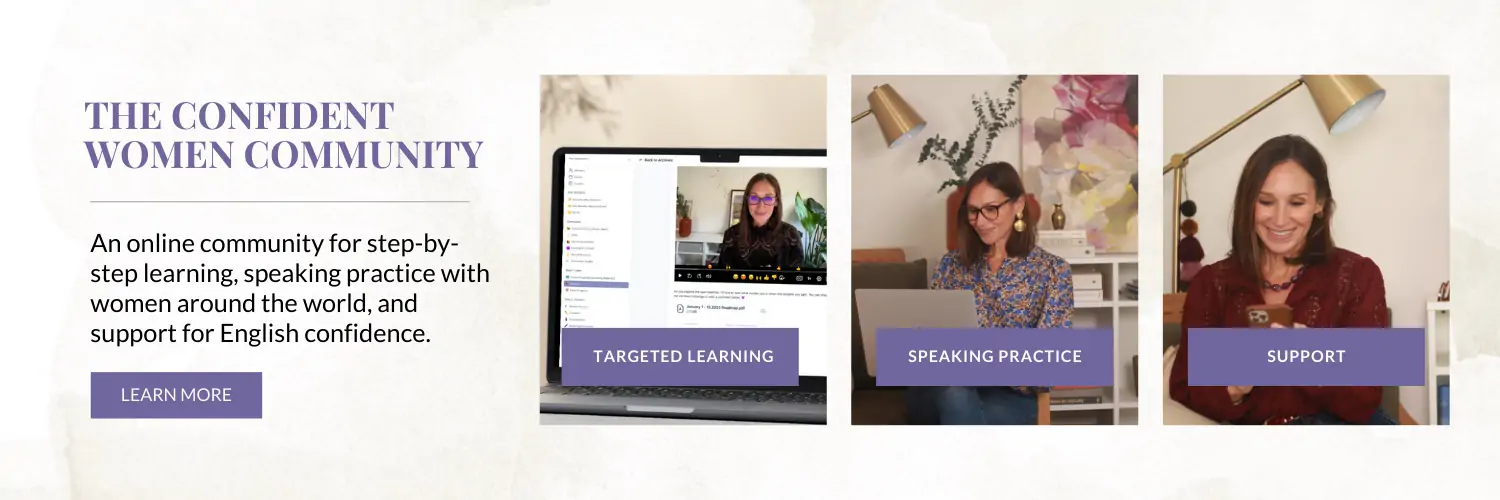#263: The Past Continuous Tense: How and When to Use It (With 6 Examples)

If you avoid some grammar tenses because you’re not sure how to use them correctly, it can lead to unnecessary grammar mistakes.
It can also make it more difficult to express exactly what you want in English conversation.
In today’s Confident English lesson, we’ll explore the past continuous tense in English. Also known as the past progressive.
That means a review of the past continuous structures so you can use them accurately. And, more importantly, you’ll learn 6 real-life examples of when to use the past continuous.
By the end, you’ll be able to use the past continuous form to confidently answer 3 questions I have for you.
The Past Continuous Tense: How and When to Use It | 6 Examples
Before we look at 6 specific examples of how and when to use the past continuous, let’s review the structure so you use the tense accurately.
The structures for the past progressive tense are as follows:
Positive: Subject + [was/were] + verb[ing]
- I was planning to call you but lost track of time.
Negative: Subject + [was/were] + not verb[ing]
- She wasn’t sleeping when you called. She was working with her phone on silent mode.
Also, be careful with your verb choice.
Stative verbs are not used in the past continuous form. These verbs, which describe a state of mind, opinion, need, or awareness, never use the past progressive.
Stative verbs include verbs such as believe, dislike, hate, like, love, need, prefer, realize, seem, understand, want, etc.
For example, we would not say, “I was preferring the winter weather before it got too cold.”
Instead, we use the simple past to say, “I preferred the winter weather before it got too cold.”
Stative verbs imply a continuous or ongoing action, so the use of the past progressive is not necessary.
Use 1: Provide Context/Background for Telling Stories
When you tell a story, you reference the past. You’re describing something that already happened or something you experienced.
To help make the story interesting, you provide context. The background. This helps to set the tone or mood. You’re providing a mental picture for your listener.
And that’s where you want to use the past continuous tense.
Scenario 1: Imagine your telling someone about a recent vacation. To highlight how relaxing it was on your day, you might provide some background details such as:
“When I woke up, the waves were rolling on shore, the sun was inching up over the mountains, warming the sand, and the palm leaves were rustling in the breeze. It was the perfect start to the vacation.”
Scenario 2: Think about an important historical event you’ve experienced. Imagine someone asking you, “What were you doing when…”
For example, “What were you doing when you heard the election results?
In describing the context, you might say, “I was at an election party. A group of us were chatting and the music was blaring when they announced the results. There was so much noise that we didn’t hear them right away.”
And that leads me to Use 2.
Use 2: Highlight Overlapping Events and Interruptions
Overlapping Events
The second scenario in Use 1 also describes overlapping events. In other words, two events happening at the same time.
To show that two events are overlapping – and to show which one started first – you’ll use the past continuous.
There are 2 structures we use to do this:
- When + Past Simple
- I was chatting with friends when they announced the results.
- When they announced the results, I was chatting with friends.
In both cases, I was chatting with friends first. Then the other action happened.
- At midnight, At 7:00 PM, In September, By the age of 12
These specific indications of time show that an event was ongoing before and after.
For example:
- By the age of 12, I was playing concerts in major cities across the country. (This was true before and after the age of 12.)
- By the time I was in my mid-30s, I was putting a significant part of my paychecks toward my retirement fund.”
- In September, I was preparing for our next major project.
- I was cooking dinner at 7 PM last night.
Interruptions
The past continuous also shows what was happening when an interruption occurred.
Scenario 3: Imagine you missed a call from a loved one and they ask you what was going on.
You might say, “I was cooking in the kitchen and the kids were watching TV with the volume on high when you called the first time. I didn’t hear the phone.”
Scenario 4: Say you’ve had a chaotic morning and you’re retelling the events to a coworker.
You might share, “The kids were sleeping deeply when the alarm rang and jolted them awake.”
Notice in those examples we’re using the same when + past simple structure.
Use 3: Emphasize Length of Time (All Day, All Morning, etc.)
Why might this be useful?
Scenario 5: Imagine you’ve accomplished a major milestone at work. You and your team recently finished an all-consuming project. And you want to emphasize how much time you’ve spent on this project.
The past continuous combined with phrases that explain the length of time help you do this.
Example phrases include:
- All day/month/year
- All morning/afternoon/evening
- All day/night
- For hours/days/weeks/months/years
In describing the effort to others, you might say:
“We were working on this – non-stop – all year. It’s hard to believe we’re finally finished.”
Here’s another example.
Scenario 6: Say you’re a new parent and you’re telling your friend how difficult last night was with your infant.
During that conversation, you might express, “It was a terrible night. She was crying all night and we hardly slept.”
Use 4: Discuss Past Habits (Always, Constantly, Usually)
Usually, when we talk about habits, we use the present simple. For example, “I always read at night before bed.”
But what if the habit is no longer true? You might have broken a bad habit. Or your younger brother grew out of a childhood habit.
This is where the past continuous is helpful. It tells us that habits from the past are no longer true.
To do this, we combine the past continuous with adverbs and adverb phrases to describe the frequency, including:
- Always
- Usually
- Constantly
- Rarely
- All the time
- The entire time
Scenario 7: Imagine you’re reminiscing about your first few years at a company. In doing so, you might say, “During my first year, I was constantly making mistakes. There was so much to learn.”
Scenario 8: You can use the tense to describe where you used to live and your neighbor’s (annoying) habits. “The entire time we lived there, our neighbors were partying and yelling every other day. In the end, we decided to sell the house and move to a more peaceful neighborhood.”
Use 5: Make a Polite Request (I was wondering if…)
You’ll notice when English speakers make polite requests, they use the past continuous.
There is a simple sentence structure we use for this: I was wondering if…
For example:
- Asking your friend for a favor: “I was wondering if we could borrow your truck for our move?”
- Inviting a coworker to your house for the first time: “I was wondering if you’d like to come to our house this weekend? We’re having some friends over for a backyard BBQ.”
Sidenote: You can use this same structure – without ‘if’ – to ask indirect questions.
This might be useful if you’re not sure it’s appropriate to ask a question.
For example:
- I was wondering what you’re doing this weekend. (Indirect)
- What are you doing this weekend? (Direct)
- We were wondering when you’ll have a decision. (Indirect)
- When will you have a decision? (Direct)
Be careful not to overuse this. The ‘I was wondering (if)…” structure is vague language. It can make the meaning less clear.
Use 6: Indicate a Change of Mind
Have you ever made a plan and then changed your mind at the last minute?
Of course, you have. We all have.
The past continuous helps us show what our original plan was and then we decided to do in the end.
Scenario 9: Imagine made plans to move to another city at some point in the past. You started making plans for 1 location but then changed your mind. You could say: “I was thinking about moving to Washington DC, but decided to move to New York instead.”
Scenario 10: Let’s say you talking about your plans for a vacation. In the process, the cost of airline tickets and airport delays changed your plans. You might tell a friend, “We were planning to go back to Europe. We haven’t visited in years. But the flight costs and the long delays made us change our minds. We’re going to travel somewhere closer to home instead.”
Now I have 3 questions for you to help you practice.
Using what you learned in this lesson, how would you answer these questions?
- Think of your most recent vacation. What was the first day like? Describe it or provide the context.
- What is a past habit you broke or grew out of? Use “When I was a kid, I always/never/constantly…”
- Tell me about a time when you changed your mind. What were you originally thinking? And what did you decide in the end?
You can share your answers — as well as your questions — with me in the comments below.
~ Annemarie

Get the Confidence to Say What You Want in English
Follow my 3-step solution to speak English with clarity, fluency, and freedom so you can say what you want with confidence.
You'll also get my Confident English lessons delivered by email every Wednesday and occasional information about available courses. You can unsubscribe any time.
More Like This
Learn English Phrasal Verbs Faster — 5 Minute Routine
Tired of forgetting English phrasal verbs the moment you need them? In this Confident English lesson, you’ll learn a 5-minute daily routine to make phrasal verbs stick—so you can remember them, use them naturally in real conversations, and finally stop second-guessing. Whether you need phrasal verbs for work, everyday conversations, or English speaking practice, this lesson gives you practical steps that fit your real life.
Sound Fluent & Professional: English Phrases for Meetings & Updates
Want to speak English more naturally at work? In this lesson, you’ll learn powerful English phrases for meetings and updates, including business phrasal verbs professionals use every day. Get the vocabulary and expressions you need to give confident project updates, explain delays clearly, and wrap up your message like a pro.
How to Give a Project Update in English at Work
Give a clear project update in English with a concise 3‑step framework. Get the phrases and structure to deliver professional project status reports confidently at work.
Professional Ways to Ask for Help in English (4-Step Formula)
Learn how to ask for help in English at work—without sounding unsure or unprepared. This 4-step formula gives you clear, professional phrases for meetings, emails, and team collaboration.
30+ English Phrases to Compliment Food Naturally and Politely
Learn 30+ natural English phrases for food and how to compliment food in English politely and sincerely. Perfect for dinner parties, eating out, and everyday English conversations.
Describe Food in English: The Ultimate List of Taste & Texture Vocabulary
Learn how to describe food in English with confident, natural vocabulary. Get taste and texture adjectives English speakers use in real conversations, from restaurants to everyday life.
© Copyright 2014-2025 Speak Confident English | Privacy Policy | Terms & Disclaimer | Online Class Policies






Thanks once again for your exhaustive explanations, Anne-Marie! Having read the material, two questions have come to my mind:
1) as for the Use 4, is Past Continuous applicable in case of bad habits only?
2) can we use Past Perfect Continuous in the examples under the Use 6?
It would be great if you help us sort this out.
Thanks,
Liana
Hi Liana, thanks for the comment and questions. For your first question, I want to make sure I understand correctly. Are you asking if this is the only way to highlight bad habits? If so, the answer is there are multiple ways we can discuss bad habits – this is just one possible option. As for use case 6, yes, we could also use past perfect continuous. By using the past continuous, we are setting the scene. You can think of it as providing background information. With the past perfect continuous, we would indicate that one past action had stopped… Read more »
Additional resource for honing English grammar skills – typeng.com. This cost-free web-based simulator offers the chance to enhance your grasp of English verb tenses. You need to peruse the inquiry and respond using the keyboard, utilizing solely the words provided beneath. Completely free of charge, and no need for registration.
When I was a kid I always preferred extra salted food but now I could never eat anything that is so salty.
I was planning to work at a call center after graduation but after hearing about my friends’ experiences I decided to work somewhere else where I can gain new skills.
The very first morning after arriving at Alex. I woke up to a wonderful view where I saw different shades of blue waves from the balcony.
Finally, here l finish the task.
l was the founder of a Club where kids were attending sessions to read books for pleasure that ‘s mean they were not forced to read a specific book. They were free to chose the author and the story.
This activity took place for many years in my agenda and
I was planning to continue the activity until l got retired, but the COVID made a mess in all my programmes.
*that means*
Here l answer the second question
When l was young , l ‘ve never got the opportunity to go to the movie theatre with my school mate.
I always should be with my brothers.
Hello Anne Marie,
Thank You for every thing.
It’s extremely interesting.
When I was young my favorit destination to spend vacations was grandparents’ place.
They were living in a Small farm.
There were many animals,as ducks hens pigeons and cats.
There was a pond where around fifty coloured fishes were swimming.
I remember, l woke up early to join grandpa in the field . there were many fruits ‘ trees.we picked up some figues for breakfast ….
I liked those days, since we spent weeks in the nature , breathing frech air and eating good food .
Hello,ann7
Sorry Anne Marie i couldn’t control my fingers because of the parkinson